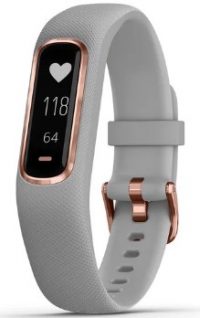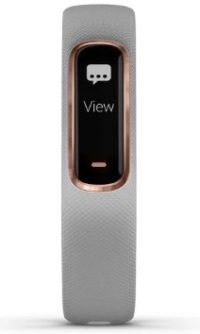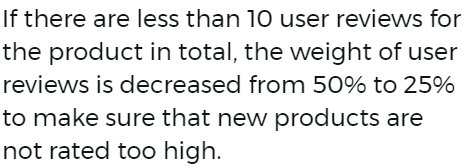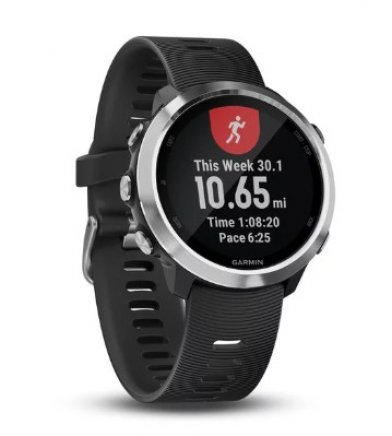Garmin Vivosmart 4 Fitness Tracker Review
Garmin Vivosmart 4 fitness tracker watch isn’t this brand’s latest and greatest product. It released in August 2018. But it remains popular and garners mostly favorable reviews. It sports a slimline band with a traditional peg and hole closure. The familiar oblong screen is framed in faux gold. The look is sleek but traditional, like an old school wristwatch with serious upgrades and enhancements.
Some of those enhancements are, frankly, hard to understand. It can be tough to get a bead on what the watch is for when it offers so many data points. The Vivosmart 4 has a pulse oximeter to measure the oxygen content in your blood, for example. That feature can pair with the sleep tracker, giving you your O2 levels during your sleep. Why would you want to know that? The only practical reason we can think of is diagnosing sleep apnea. But that is a decision and process best left to a doctor, not a smartwatch.
We don’t want to be naysayers of the benefits of fitness and activity trackers. But in this particular deep dive, we’re going to turn a critical eye towards the Garmin Vivosmart 4, asking the question: when is enough, enough?
Low profile slimline design is like you're not even wearing the watch
The battery lasts a long time between charges
Price is competitive compared to other watches with similar features
Uses metrics to measure your energy and stress levels, and advises accordingly
Aimed at recreational fitness buffs; not a special-featured run watch or the like
Body Battery feature helps you establish habits that won't drain energy
OLED screen is bright and easy to read
The screen is small, so not a lot of numbers can fit on it
NO GPS capability, and stride length not always accurate
No music streaming on this model
Tech Specs
The battery is lithium polymer and rechargeable with an included cable that doubles as a data cable. It's a USB cable and port, not a micro USB as you might expect. The battery will last up to seven days, and that is with constant wear and use. Since there's no battery-devouring GPS, the seven days is the only charge length.
Though it won't matter to all our readers, the Garmin Vivosmart 4 can stand up to a wide temperature range. It will keep going as low as -4 degrees Fahrenheit and as high as 122 degrees Fahrenheit. (That's -20 to 50 Celsius). The charging range, the temperatures at which the watch will take and hold a charge, covers 32 to 113 degrees Fahrenheit (0 to 45 Celsius). Both the operating and charging ranges are good to know if you plan an excursion with temperature extremes, like a desert bike ride or camping trip to Alaska. You don't want the watch to leave you hanging in the cold or heat.
For wireless connectivity, you have a few options. The watch can use Bluetooth, or standard 2.4 GHz wireless signals. But Garmin also built-in ANT+ capability. What that means in practical terms is that the watch can communicate with any receiver or transmitter running ANT+ protocol. This gives you more consistent coverage, with greatly reduced chance of losing your signal or data out in the wild.
Garmin streamlined the water-resistance rating for the Vivosmart 4. Instead of a confusing ATM number, the manual just says "swim." To clarify, that means the watch is good to go underwater pressures encountered at 50 meters deep. That's more than satisfactory for pool swimming, the shower, or getting caught in a rainstorm. Your sweat won't affect the screen or functioning either.
The Vivosmart 4 is a lean machine, more focused on overall wellness than individual sports. So we don't have a long list of specific exercises the watch can track. What the watch does, once you dial in settings, is to sense when you are doing cardio, including elliptical machines and other indoor equipment, and measure activity level and effectiveness. It will do the same thing for swims and lifting sessions. Some reviewers doubt the accuracy of the strength training mode, which is pretty typical of even high-end fitness watches.
Throughout the day, and before sleep, the watch will give you calorie burn, number of steps, and equivalent stairs and floors climbed during the day. And for something that isn't sport specific, the Vivosmart 4 sure does house a lot of sensors in its tiny frame. Those include all-day optical wrist heart rate, the pulse oximeter for O2 levels, and an ambient light sensor. The light sensor adjusts the brightness of your screen, making it easy to read in direct sunlight or at night. You also get an altimeter and accelerometer. The altimeter detects changes in your height above sea level, helping verify your location and also crunching the numbers for floors climbed. The accelerometer senses changes in how fast you are moving, and enables the watch to automatically measure your cardio or strength activity without you having to tell it what you're up to.
Who Needs It
Several studies, including a 2011 one that appeared in the International Journal of Behavioral Nutrition and Physical Activity, confirm that 10K steps are a reasonable guideline for most healthy adults. But some of us walk for work, and others are sedentary and may just need 3 or 4K steps to start seeing incremental improvements.
The Garmin Vivofit will push 10K steps on you but remember you have control over the settings and you can decide what's feasible for you. Perhaps you'd like your goal to be walking for 20 minutes each day, without worrying about pace or calories. The Vivofit 4 will help you do that and will give you gentle reminders to go meet your goal if you are lagging behind what you set for yourself.
While the Garmin Vivofit 4 does have strength training tracking modes, it's typically less effective than cardio measurements. Most lifters we know are more focused on weight and number of reps, less on calorie burn and heart rate. We can't imagine a watch like this catching on with many powerlifters or other strength athletes.
Also, if you practice a specific and technical sport, like cycling or running, the watch will most likely fall short. It does not give any input on stride length, muscular efficiency, or VO2 max training. It does provide heart rate, but so do many other fitness trackers that also cater to scientific running. Running and cycling computers are notoriously expensive, but the price of the Vivofit 4 could cover a large chunk especially if you go after a starter model.
Comfort/Ease of Use
Navigating the menu takes some practice. It is a touch screen, activated by a side button. You can sync the watch with your phone using the Garmin Connect app, or send data to your PC if you want a big readout. Since functions are pretty basic-steps, calories, sleep, floors climbed, active minutes, heart rate-there is not a lot of information to get lost in.
The pulse oximeter, which we mentioned in the intro, is not so basic. These sensors began appearing in smartwatches a few short years ago. Is it necessary to know the oxygen percentage in your blood at all times? It isn't typically one of the vital signs you have taken during a medical checkup. Before they became a norm for tracking watches, finger pulse oximeters were usually part of a hospital stay. The numbers are important for the treatment of certain conditions or injuries. And as we mentioned, not getting enough oxygen during sleep is a serious condition that needs medical treatment.
The Garmin Vivofit 4 is not a medical device. It's a bit ambiguous to think it could take the place of one. We don't want to discourage anyone from getting a product that will help them get more fit, but these watches are made to be worn all the time. After a while, you may feel you are doing something wrong by not wearing yours. But there are times, like during deep meditation or a tranquil beach trip, when unplugging completely is the wise move. If you are going to spend the money on a watch like this, we encourage you to use critical thinking and ask if every single feature is something you actually need or will even use regularly.











